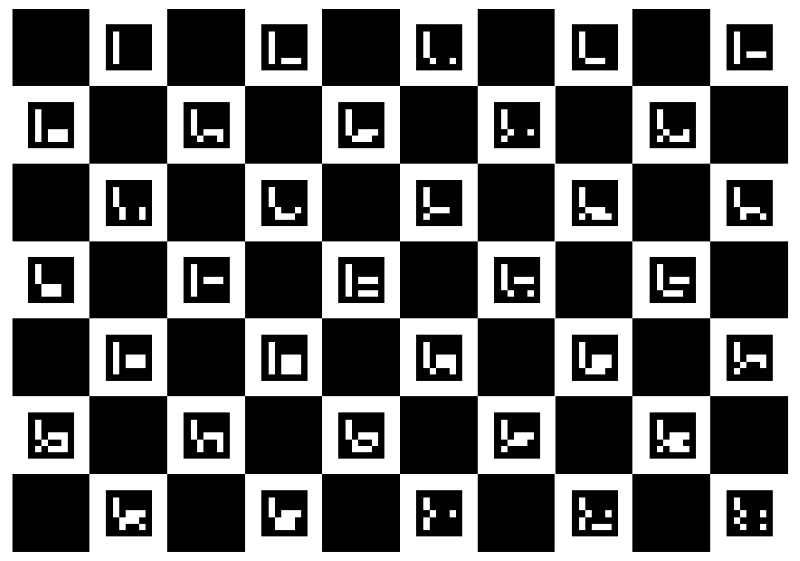To perform camera calibration as we discussed earlier, we must obtain corresponding 2D-3D point pairings. With ArUco marker detection, this task is made simple. ArUco provides a tool to create a calibration board, a grid of squares and AR markers, in which all the parameters are known: number, size, and position of markers. We can print such a board with our home or office printer, with the image for printing supplied by the ArUco API:
Ptr<aruco::Dictionary> dict = aruco::Dictionary::get(aruco::DICT_ARUCO_ORIGINAL);
Ptr<aruco::GridBoard> board = aruco::GridBoard::create(
10 /* N markers x */,
7 /* M markers y */,
14.0f /* marker width (mm) */,
9.2f /* marker separation (mm) */,
dict);
Mat boardImage;
board->draw({1000, 700}, boardImage, 25); // an image of 1000x700 pixels
cv::imwrite("ArucoBoard.png", boardImage);
Here is an example of such a board image, a result of the preceding code:

We need to obtain multiple views of the board by moving either the camera or the board. It is handy to paste the board on a piece of rigid cardboard or plastic to keep the paper flat while moving the board, or keep it flat on a table while moving the camera around it. We can implement a very simple Android UI for capturing the images with just three buttons, CAPTURE, CALIBRATE, and DONE:

The CAPTURE button simply grabs the grayscale image buffer, as we saw earlier, and calls a native C++ function to detect the ArUco markers and save them to memory:
extern "C"
JNIEXPORT jint JNICALL
Java_com_packt_masteringopencv4_opencvarucoar_CalibrationActivity_addCalibration8UImage(
JNIEnv *env,
jclass type,
jbyteArray data_, // java: byte[] , a 8 uchar grayscale image buffer
jint w,
jint h)
{
jbyte *data = env->GetByteArrayElements(data_, NULL);
Mat grayImage(h, w, CV_8UC1, data);
vector< int > ids;
vector< vector< Point2f > > corners, rejected;
// detect markers
aruco::detectMarkers(grayImage, dict, corners, ids, params, rejected);
__android_log_print(ANDROID_LOG_DEBUG, LOGTAG, "found %d markers", ids.size());
allCorners.push_back(corners);
allIds.push_back(ids);
allImgs.push_back(grayImage.clone());
imgSize = grayImage.size();
__android_log_print(ANDROID_LOG_DEBUG, LOGTAG, "%d captures", allImgs.size());
env->ReleaseByteArrayElements(data_, data, 0);
return allImgs.size(); // return the number of captured images so far
}
Here is an example of ArUco marker boards detected using the previous function. A visualization of the detected markers can be achieved with cv::aruco::drawDetectedMarkers. Points from the markers that were detected properly will be used for calibration:

After obtaining enough images (around 10 images from various viewpoints is usually sufficient), the CALIBRATE button calls another native function that runs the aruco::calibrateCameraAruco function, with the saved arrays of point correspondences as follows:
extern "C"
JNIEXPORT void JNICALL
Java_com_packt_masteringopencv4_opencvarucoar_CalibrationActivity_doCalibration(
JNIEnv *env,
jclass type)
{
vector< Mat > rvecs, tvecs;
cameraMatrix = Mat::eye(3, 3, CV_64F);
cameraMatrix.at< double >(0, 0) = 1.0;
// prepare data for calibration: put all marker points in a single array
vector< vector< Point2f > > allCornersConcatenated;
vector< int > allIdsConcatenated;
vector< int > markerCounterPerFrame;
markerCounterPerFrame.reserve(allCorners.size());
for (unsigned int i = 0; i < allCorners.size(); i++) {
markerCounterPerFrame.push_back((int)allCorners[i].size());
for (unsigned int j = 0; j < allCorners[i].size(); j++) {
allCornersConcatenated.push_back(allCorners[i][j]);
allIdsConcatenated.push_back(allIds[i][j]);
}
}
// calibrate camera using aruco markers
double arucoRepErr;
arucoRepErr = aruco::calibrateCameraAruco(allCornersConcatenated,
allIdsConcatenated,
markerCounterPerFrame,
board, imgSize, cameraMatrix,
distCoeffs, rvecs, tvecs, CALIB_FIX_ASPECT_RATIO);
__android_log_print(ANDROID_LOG_DEBUG, LOGTAG, "reprojection err: %.3f", arucoRepErr);
stringstream ss;
ss << cameraMatrix << endl << distCoeffs;
__android_log_print(ANDROID_LOG_DEBUG, LOGTAG, "calibration: %s", ss.str().c_str());
// save the calibration to file
cv::FileStorage fs("/sdcard/calibration.yml", FileStorage::WRITE);
fs.write("cameraMatrix", cameraMatrix);
fs.write("distCoeffs", distCoeffs);
fs.release();
}
The DONE button will advance the application to AR mode, where the calibration values are used for pose estimation.